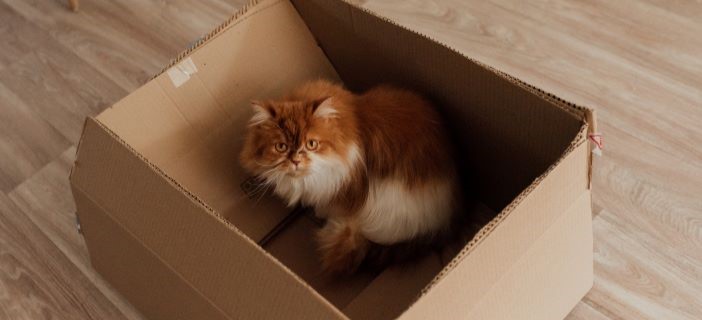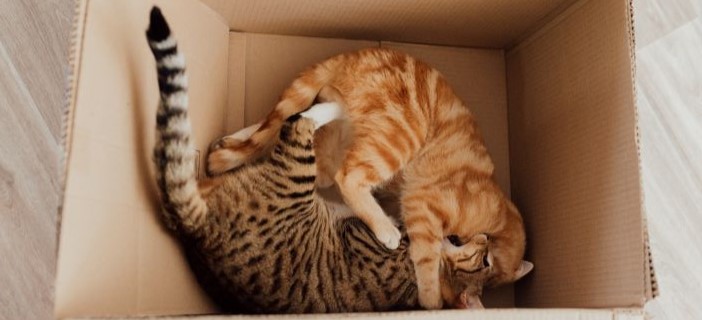Moving house is a stressful time for the entire household, including your cat. Cats are creatures of habit and thrive from routine, familiarity and predictability in their lives so relocating with a cat in tow is not going to be an easy task.
But there are plenty of ways you can make moving house a more pleasant experience for your pet. Here we explain how you can transport and settle your cat into a new home smoothly.

Preparing your cat to move
You should consider preparing your cat to move long before you physically move into your new home. Changes and disturbances in a cat’s life can leave them feeling scared and anxious.
Around one week before your move, introduce your furry friend to a room in your current house that includes a litter tray, food and water bowls, toys and anything else that provides comfort to your cat.
As moving day approaches, leave your pet in this now familiar room undisturbed with all windows and doors closed to ensure safety.
Alternatively, you can book your cat into a cattery during the moving period to keep them stress-free.
Moving your cat
Cats love routine and feel uneasy when change occurs. When transporting your cat on moving day try to follow your cat’s usual routine as closely as possible.
Try to maintain normal feeding times and ensure you make time to give your cat the one-on-one attention they’re so used to.
Remember, cats read your emotional cues, so the calmer you are, the calmer your cat will also be.
Transporting your cat to a new home
Travel with your cat in a safe and enclosed carrier just like you usually would. Leaving cats loose in the car increases the risk of an accident. Keep the carrier secure throughout the journey by using a seat belt.
Consider placing familiar blankets or bedding in the carrier to further relax your pet. Ensure they have access to water and offer them reassurance on the journey.
The first day your cat is home
On the first day, introduce your cat to one room in the new house. Place the carrier in this room and leave your pet to explore and become familiar with its new setting. Restrict your cat to this room until the rest of the family and house are sorted and settled.
Keep other animals and small children away from your cat until they show signs of safety and comfort in their new home.

Settling your cat into the new home
All cats are different and will adapt to their new surroundings at different paces. Don’t rush your cat and allow them to explore in their own time.
Your pet will let you know when they are settled as they will begin to leave their scent markings by rubbing their cheeks on furniture around the house.
Give your cat time and space
Cats are likely to struggle and become scared and confused by a house move. Try to sympathise with what they may be feeling and offer support by leaving them to adjust at their own rate.
Wait for your cat to let you know they are ready to explore the rest of their new environment before forcing them to. Ensure to keep all windows and doors shut to avoid your cat escaping and becoming lost.
Let your cat fully settle before letting them outside
Your cat should remain inside your new home for at least three weeks before being able to roam the outside world. When your cat is ready to step outside, go with them and offer friendly, verbal encouragement.
It is recommended to let your cat outside before feeding time, so they are inclined to come back.
Interact with your cat on their own terms
You may be missing your cat and worried about how they are settling in but be sure not to push your pet out of their comfort zone. Wait for your cat to come to you which they will do when they are ready.
Be sure to maintain regular feeding times and keep to a daily routine even while the house move is ongoing to minimise your pet’s stress levels.

Moving home with your cat quick tips
We hope this advice results in a stress-free move for you and your cat. Here is a quick round-up of our tips for a seamless transition as you move your cat into a new home
Choose one room for your cat to settle in
This room should act as a sanctuary for your cat in your new home. New territory can overwhelm your pet so allowing them to adjust to just one room at a time will reduce tension.
Give your cat places to hide
Cats love to hide in the smallest of spaces. Hiding spots offer great refuge to cats and make them feel calm and secure. Hiding also allows your pet to escape the chaos and commotion as they feel comfortable in enclosed safe spaces.
By providing your cat with places to hide you give them their own space where they can go and relax if they feel stressed.
Set up your cat’s room with everything they need
Ensure the room that your cat is introduced to first has everything they need to feel happy and at ease. The chosen ‘cat room’ should include water, food, a litter tray, toys and any other items that you think would be beneficial to your pet.
Make the room comfy and safe
Place familiar items such as blankets, bedding, pillows and toys to make the room comfy and cosy. This is where your cat will spend most of their time for at least the first two weeks of being in a new home so it’s important to fill it with items they recognise and have connections to.
Consider using a pheromone diffuser
A pheromone diffuser replicates a variety of different pheromones known to calm and soothe cats. They have no obvious scent that can be detected by human senses, but cats can detect pheromones that make them feel safe and reduce anxiety.
Make sure the whole house is escape-proof
It’s important to cat-proof not just your cat’s dedicated room but the whole house. Cats can be sneaky and may try to make an escape. Ensure all windows and doors are closed and you know where your cat is always.
Some cats are tempted to return to their old house after moving, so make sure to update your cat’s microchip with the new address. It may also be worth informing the new owners of the old address of your details so they can contact you in case they get a furry visitor.